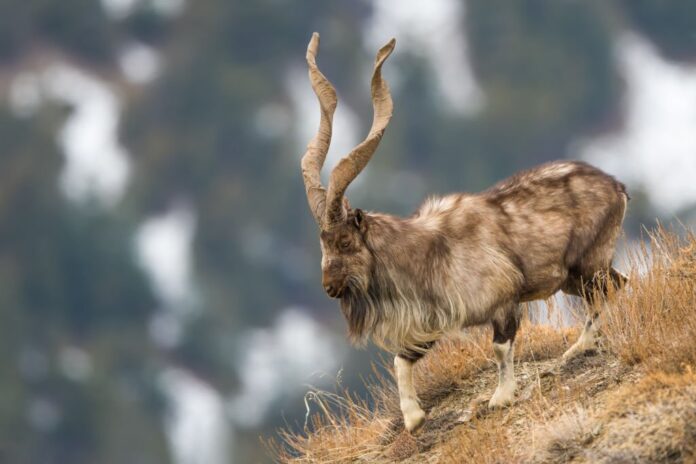ISLAMABAD: When the International Union for Conservation of Nature (IUCN) classified markhor, or wild goat, as an endangered species in Pakistan, Khyber Pakhtunkhwa worked hard to protect its population, which has more than doubled in the last three decades.
As the world celebrated World Wildlife Day on Thursday, the local community in the nation organised workshops and seminars to raise awareness about the importance of protecting markhor.
They pledged to preserve the animal from illegal hunting and to work with the government to protect wildlife.
Pakistan is well-known for its markhor, which is distinguished by its nimble and sure-footed nature, as well as its long winter coat and massive spiral horns that can reach more than 1.5 meters (150 inches) in length on males.
They inhabit the highest mountains and can be found in the Khyber Pakhtunkhwa’s Chitral, Kohistan, and Kalam regions, as well as Gilgit-Baltistan.
Markhor was listed as an endangered species by the IUCN in 1994 due to overhunting for meat and horns, and its population number was estimated to be less than 2,500 at the time.
However, according to the most recent government data, there are between 5,000 and 6,000 wild goats.
“We have created the best model of community conservators,” Muhammad Altaf Ali Shah, divisional forest officer in Wildlife Department’s Chitral office, told Anadolu Agency.
“The department issues licenses to hunt only older markhors. We do not allow the hunter to shoot females or newborns,” Shah said.
Hunting female markhor or young babies is prohibited, he said, adding: “According to the Khyber Pakhtunkhwa Wildlife Act 2015, any hunter who kills a female or a young markhor faces a six-year prison sentence or a fine of up to 150,000 Pakistani rupees (approximately $850), or both.”
The government uses the license money, which is in dollars, to support local communities by building schools, mosques, health centres, and even providing scholarships to local students, the official said.
These incentives encourage local communities to avoid killing markhor and instead push them to care for the wild goats, he explained.
“The most recent markhor hunt license was sold for $160,000,” Salahuddin Jamaluddin, a divisional forest officer in Wildlife Department’s Peshawar office, told Anadolu Agency.
“We spend 80 percent of the money on the local community, who help us with our conservation efforts, and 20 percent on the government for administrative expenses,” he explained.
Salahuddin said: “The locals have few job opportunities because the terrain is hilly and occasionally snow-covered. However, by conserving markhor, the locals may now earn a living while also preserving the animal.”
He added that his wild goat has been a source of income for them as they have worked their way out of poverty.
Pledges on World Wild Life Day
The name Markhor comes from the Persian language and means “snake eater.” There are about five different types of markhor, with Astor markhor and Kashmiri markhor being the most popular for hunting.
“In early 2000, we began our nationwide campaign of seminars, workshops, and local gatherings. With the passage of time, the locals realized that it is essential for their benefit as well to save this beautiful species,” Shah said.
“On World Wildlife Day, we gather them all in different areas and they make pledges to protect this animal at all costs, and most of the time locals notify us of illegal hunting,” the official added.
When a foreigner hunts a markhor, he keeps the animal’s horns as a trophy, but the meat is given to the locals, and everyone celebrates the hunt.
“One markhor meat can weigh over 110 kilograms at times, and it is distributed among all the people who assist the hunter,” said Sajmal Yoodon, a local who accompanied a foreign documentary filmmaker to film on markhor in 2019.
“At the feast, they’re all having a great time together. This is another opportunity to promote local brotherhood and harmony,” he added.
“We have a very strong attachment for this animal because it symbolizes the pride of our country,” he said, referring to Pakistan’s national animal.
“When you set your eyes on this animal for the first time, it gives you a mixed feeling of adventure and fear,” he said of his hunting experience.
“It took us eight days to complete the hunt because if you miss your first fired bullet, the animal flees to its caverns in the upper mountains and takes days to return,” he added.























